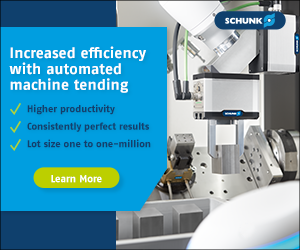Robots Armed for More Than Machine Tending
Although they’re more eager than ever to embrace robotic arms, manufacturers that don’t look beyond the machine tool risk missing out on opportunities to automate processes like deburring, cleaning and inspection.
Share









Takumi USA
Featured Content
View MoreJohn Lucier says he doesn’t spend nearly as much time touting the general benefits of part-handling robotic arms as he used to. “Machinists and machine tool people get it; we’re over the hump,” explains the national automation manager for machine tool distributor Methods Machine Tools Inc. (Sudbury, Massachusetts). “Recently, it’s been more about coming up with that perfect mousetrap.”
Before that work can begin, a manufacturer must understand that the proverbial better mousetrap can cover far more than just loading and unloading machine tools. To overlook processes like cleaning, marking, inspection and particularly deburring is to risk missing out on the full breadth of the opportunity afforded by robotic automation, Mr. Lucier says.
In some cases, manufacturers struggle to justify the capital expense of a robot arm that’s likely to cost more than the equipment with which it is paired—substantially more even. However intuitive this thinking is, comparing cost percentages of robot to machine isn’t a fair way to evaluate whether a downstream process is suitable for automation, Mr. Lucier says. A better comparison, he claims, is between the cost and time associated with the manual labor that a robot arm could replace. The argument essentially goes like this: If the cost of manually tending a $30,000 marking machine doesn’t substantially differ from that of tending a $100,000 machine tool, why would a robot arm be any less justified?
In other cases, manufacturers that eagerly take the first step are then slow to recognize a case in which automation begets the need for more automation. “More often than not you’ll make more parts an hour with a robot on your machine tool, but more parts an hour means more parts to deburr, too,” he explains. “It’s always ‘Look at how much we’re cutting now, this is spectacular! But now we can’t inspect them fast enough.’ I’ve seen this from companies with single robots all the way up to large customers with 30-foot rails with machines on both sides. Sometimes, it doesn’t even enter their minds that a process can be automated.”
One reason a process might be overlooked as a candidate for robotic automation is complexity, Mr. Lucier says. Loading and unloading machine tools is one thing; programming robot arms to precisely articulate workpieces around spinning deburring tools (which are subject to wear over time) is quite another. Nonetheless, deburring has become a particular focus of late, he says, citing the labor-intensive nature of a process that large portions of the market still perform manually. Tedium and repetition can lead to mistakes or even injury, he says. What’s more, the dedication, skill and attention to detail this process often requires not only can be difficult to find, but might be better applied to other value-added tasks anyway. The modular cell shown above, an example of a high-end solution from Methods, demonstrates what is possible and could represent a way forward for many high-production operations, Mr. Lucier says.
Yet, he emphasizes that, much to the surprise of some customers, such high-end systems aren’t necessary in many cases. Complexity, he explains, may well be present only in the eye of the beholder—the shop owner who hasn’t considered an alternative method that might lend itself better to robotic automation. Returning to the example of deburring, he says he might ask a customer if parts lend themselves to being pressed against an abrasive brush or belt rather than being manipulated around a cutting tool. Another option, cyrogenic deburring, is not only similarly simple to automate, but can also clean surfaces even as it freeze-blasts them smooth, he says, making it particularly useful in the medical industry. Or perhaps a task can be automated by adding stations around existing robots instead of adding new ones. An example of this might be a machine-tending arm making an extra stop for simple part measurements on an linear variable differential transformer (LVDT) sensor or air gage.
Mr. Lucier emphasizes that there are many different ways to mark a part, clean a part or perform any other downstream process, and different manufacturers have vastly different needs. Nonetheless, these processes stand to improve as much from robot-arm tending as primary metalcutting operations. With the right expertise, robotic automation can be more viable than meets the eye. And with an open mind, it might be simpler than it initially appears.
Related Content
Mastercam Software Improves Programming Flexibility
IMTS 2024: Mastercam introduces Mastercam 2025, with features including Mastercam Deburr for automated edge finishing, finish passes, mill-turn support for Y-axis turning and automatic license update notifications.
Read MoreHow to Accelerate Robotic Deburring & Automated Material Removal
Pairing automation with air-driven motors that push cutting tool speeds up to 65,000 RPM with no duty cycle can dramatically improve throughput and improve finishing.
Read MoreHeule Tool Automates Cross Hole Deburring Process
The COFA tooling range is well suited for a wide range of applications, including forks, yokes, common rails, castings, tubes with cross bores and other workpieces with cross bores in their main bores.
Read MoreTapmatic Showcases Deburring Tool for a Consistent Edge Break
IMTS 2024: Tapmatic Corp. exhibits the DeBurr-Z deburring tool for simplified programming and a consistent edge break.
Read MoreRead Next
5 Rules of Thumb for Buying CNC Machine Tools
Use these tips to carefully plan your machine tool purchases and to avoid regretting your decision later.
Read MoreRegistration Now Open for the Precision Machining Technology Show (PMTS) 2025
The precision machining industry’s premier event returns to Cleveland, OH, April 1-3.
Read MoreBuilding Out a Foundation for Student Machinists
Autodesk and Haas have teamed up to produce an introductory course for students that covers the basics of CAD, CAM and CNC while providing them with a portfolio part.
Read More











































